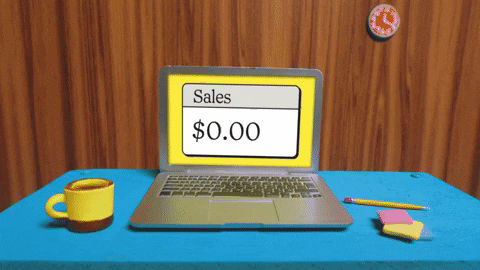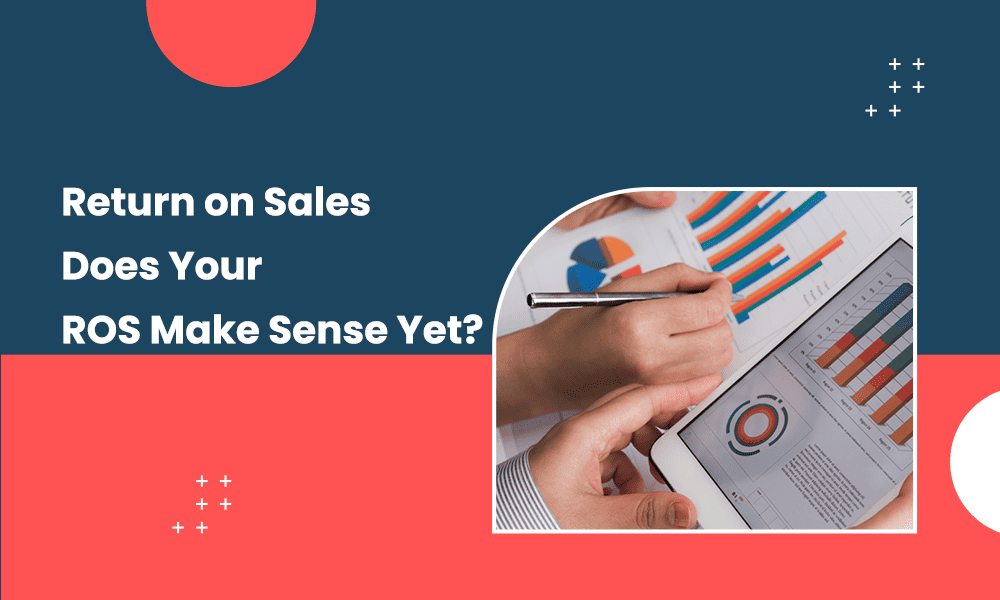Every company, no matter the size, wants to make stellar profits from its ongoing sales.
After all, profitability is a key indicator of success and sustainability in the business world. To truly gauge your company’s financial performance and assess its efficiency, you can put your money where your mouth is, so to speak, by calculating your return on sales (ROS).
ROS is a crucial metric that provides valuable insights into a company’s ability to generate profits relative to its sales revenue. By understanding and tracking this metric, businesses can make informed decisions that drive profitability now and well into the future.
If you have yet to track ROS for your small business, then you won’t want to miss this comprehensive guide. In this article, we’ll provide you with a complete understanding of ROS, including its definition, significance, and practical applications.
We’ll also walk you through the process of calculating your return on sales and shed light on what constitutes a good ROS benchmark.
So, without further ado, let’s dive into the world of ROS and discover how it can propel your business toward greater financial success.
Table of Contents
What Is Return on Sales?
Return on sales is a ratio or calculation that proves how efficiently your small business is operating. You can use ROS to determine, dollar by dollar, how much operating profit you’re earning per sale your company makes.

Your ROS can either increase or decrease. If your startup’s return on sales is on the rise, this indicates healthy growth for your business. You’re generating a lot of new leads, converting them to customers, and maintaining your current customers to pad your bottom line.
A decrease in ROS is a clear indicator that something is not working. Perhaps there’s a disconnect in your sales process, you’re struggling with lead generation, your conversion rate is suffering, your marketing isn’t reaching the right parties, or your new product or service flopped.
It’s natural for a company’s ROS to fluctuate slightly over time, but severe dips, especially negative dips, are worth paying attention to.
How to Calculate Return on Sales
As we mentioned in the section above, return on sales is a calculation. You can follow a handy-dandy, convenient formula to determine your ROS right now.
The formula is as follows:
Return on Sales (ROS) = Operating profit / net sales revenue x 100.

You’re not looking at your sales over the entire life of your company, of course, but only for the most recent sales period.
Let’s take you through an example so you can better understand how it works.
Over the last quarter, your sales income was $400,000. You also spent $120,000 on expenses.
You’d first subtract those two numbers, which equals $280,000. That’s your operating profit.
Then you take your operating profit and divide it by the net sales, i.e., $400,000.
280,000/400,000 = 0.7
And multiply that by 100 to get the percentage:
0.7*100 = 70%
Your Return on Sales or ROS is 70%.
Read also: What Nobody Tells You About CRM ROI: A Thought-Provoking Guide
What Is a Good Return on Sales Ratio?
The above return on sales ratio is merely an example to show you how the return on sales calculation should work. Your ROS could be lower or higher.
How do you know what a good return on sales is for your small business? You should review a collection of factors to make that determination.
Company trends
It can be difficult to formulate trends for a small business that has maybe a year of history under its belt.
But you still must try to calculate, and if you don’t, then it becomes too difficult to pinpoint what a good return on sales ratio is versus a bad one.
If your startup has existed for years, then you’re in luck. You can review historical data to see how your sales and income have fluctuated over time.
At the start of your company, you’re going to spend more money. You have to spend on computer equipment, software, business cards, advertising, marketing, and more.

Your expenses will never be as enormous as they are at the start — unless your small business expands or merges.
However, if you have year-over-year data, it’s easier to determine if your expenses from the first year of your business operations were profitable.
In your second year, your expenses weren’t nearly as high, and the same goes for your third and fourth years. Thus, your ROS was likely higher as well, with fewer expenses to calculate.
If your ROS over the last year or two held steady at about $0.17, which means you’re making 17 cents for every dollar you spend, then you know that the $0.17 is the lowest you want your return on sales to drop.
Ideally, you want to increase the number this year and keep increasing it in the years to come. If the return on sales grows by at least 10 percent year-over-year, then your small business is on the right track.
Keep doing what you’re doing at the very least and find new ways to expand your revenue streams or earn more with your current revenue streams.
Read also: 19 Types of Email That Will Boost Your Email Marketing ROI
Industry trends
You can’t look at your small business ROS alone and use that as the sole benchmark for determining what a healthy return on sales is. That’s far too internal and insular.
Instead, you should also assess your industry as a whole.
You’re part of that industry, so undoubtedly, whatever changes your industry experiences are going to trickle down to you eventually.
The changes might not hit you so hard (or they very well may), which means that positive developments might not lead to a huge ROS spike either (or they could!).
As often as you can, you want to read through current industry reports. These reports may be produced quarterly or annually.
Either way, you can learn what the industry-wide return on sales rate is. This will usually be represented as an average, such as 18 percent.
Now, just because your industry-wide ROS average is 18% doesn’t mean that your small business return on sales will be identical.

If you’re a newer or small business, you might always be playing some degree of catchup to the industry average because of your size.
However, you want to use the industry-wide return on sales average as a litmus test of sorts.
If your industry is having a good year and you are as well, and if your return on sales ratio isn’t terribly lower than the average industry rate, you’re doing well.
However, if your ROS is dropping while the industry’s ROS holds steady, that means your small business specifically is doing something wrong.
On the other hand, if your industry’s return on sales is lower than average this year and you too have been feeling the effects, then it’s not necessarily your company’s fault.
That said, you should still do what you can to raise your return on sales.
Competitors
You operate your small business independently of your competitors, but it’s still good to know what they’re doing just as it’s good to have a gauge on their return on sales rates.
You’ll want to look for published company reports that detail this data.
Since your competitors produce and sell similar products and services, if their ROS is far higher than yours, your small business has a lot of making up to do somewhere.
Should you be the one with the higher ROS rate of the two, then now it’s your competitors who have to rush to meet your standards and not the other way around.
7 Fundamental CRM Metrics For Small Business Owners
Why Your Small Business Must Track Return on Sales
Is tracking your ROS sales rate worthwhile? We think so, for the following reasons.

Helps determine if your material costs are fair
Are you paying too much for materials? You might never know until you sit down to calculate your ROS and then compare your return on sales ratio with that of your competitors or your industry as a whole.
If you’re overpaying, that will continue to chew into your bottom line quarter after quarter and year after year.
You might revise current contracts with materials suppliers or even find a new supplier to work with who’s more cost-effective.
Helps manage labor costs
Labor costs are a necessary evil, but this is another area in which many companies can overspend without even realizing it.
Once you’ve gauged that your labor costs are excessive for your industry, you might revise your onboarding and training processes to produce better employees. You might also change your interviewing process.
Increases sales
As if the above reasons weren’t convincing enough, yet another reason to track your business’s return on sales is to earn more money.
You can’t plug the holes in your sales strategy that you don’t find. By tracking your ROS and measuring it over time, you’ll have fewer of those holes.
Read also: Track These 15 Marketing Metrics to Grow Your Business
Conclusion
Return on sales, or ROS, is an essential calculation that provides valuable insights into the profitability of your company.
By measuring how much profit your business generates relative to its sales revenue, you gain a clearer understanding of your financial performance and efficiency.
If you have yet to track your ROS, don’t worry—it’s never too late to start. By initiating the practice now, you are building a foundation of historical data that will be instrumental in influencing your future return on sales rate.
Tracking return on sales allows you to monitor the effectiveness of your sales strategies, pricing decisions, cost management, and overall financial health.
It helps you identify areas where you can improve profitability and make informed adjustments to your business operations. Whether you’re a small business or a larger corporation, understanding and optimizing your ROS is crucial for long-term success and sustainability.
So, don’t delay any further. Start calculating your ROS and make it a regular part of your financial analysis. By consistently tracking this metric, you will have a clearer picture of your company’s financial performance, identify areas for improvement, and make strategic decisions that enhance profitability.
Wishing you all the best in your journey to maximize your return on sales and achieve outstanding financial results for your company. Here’s to a prosperous future!
